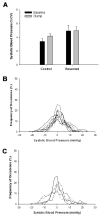Effect of bilateral carotid body resection on cardiac baroreflex control of blood pressure during hypoglycemia
- PMID: 25870188
- PMCID: PMC4507506
- DOI: 10.1161/HYPERTENSIONAHA.115.05325
Effect of bilateral carotid body resection on cardiac baroreflex control of blood pressure during hypoglycemia
Abstract
Hypoglycemia results in a reduction in cardiac baroreflex sensitivity and a shift in the baroreflex working range to higher heart rates. This effect is mediated, in part, by the carotid chemoreceptors. Therefore, we hypothesized hypoglycemia-mediated changes in baroreflex control of heart rate would be blunted in carotid body-resected patients when compared with healthy controls. Five patients with bilateral carotid body resection for glomus tumors and 10 healthy controls completed a 180-minute hyperinsulinemic, hypoglycemic (≈3.3 mmol/L) clamp. Changes in heart rate, blood pressure, and spontaneous cardiac baroreflex sensitivity were assessed. Baseline baroreflex sensitivity was not different between groups (P>0.05). Hypoglycemia resulted in a reduction in baroreflex sensitivity in both the groups (main effect of time, P<0.01) and responses were lower in resected patients when compared with controls (main effect of group, P<0.05). Hypoglycemia resulted in large reductions in systolic (-17±7 mm Hg) and mean (-14±5 mm Hg) blood pressure in resected patients that were not observed in controls (interaction of group and time, P<0.05). Despite lower blood pressures, increases in heart rate with hypoglycemia were blunted in resected patients (interaction of group and time, P<0.01). Major novel findings from this study demonstrate that intact carotid chemoreceptors are essential for increasing heart rate and maintaining arterial blood pressure during hypoglycemia in humans. These data support a contribution of the carotid chemoreceptors to blood pressure control and highlight the potential widespread effects of carotid body resection in humans.
Keywords: blood pressure; carotid body tumor; chemoreceptor cells; glucose.
© 2015 American Heart Association, Inc.
Figures




Similar articles
-
Role of the carotid body chemoreceptors in baroreflex control of blood pressure during hypoglycaemia in humans.Exp Physiol. 2014 Apr;99(4):640-50. doi: 10.1113/expphysiol.2013.076869. Epub 2014 Jan 10. Exp Physiol. 2014. PMID: 24414173 Free PMC article.
-
Baroreflex and chemoreflex function after bilateral carotid body tumor resection.J Hypertens. 2003 Mar;21(3):591-9. doi: 10.1097/00004872-200303000-00026. J Hypertens. 2003. PMID: 12640254
-
Do the carotid bodies modulate hypoglycemic counterregulation and baroreflex control of blood pressure in humans?Adv Exp Med Biol. 2012;758:129-35. doi: 10.1007/978-94-007-4584-1_18. Adv Exp Med Biol. 2012. PMID: 23080153 Free PMC article.
-
Baroreflex failure syndrome after bilateral excision of carotid body tumors: an underestimated problem.J Vasc Surg. 2000 Apr;31(4):806-10. doi: 10.1067/mva.2000.103789. J Vasc Surg. 2000. PMID: 10753291 Review.
-
Overt and Subclinical Baroreflex Dysfunction After Bilateral Carotid Body Tumor Resection: Pathophysiology, Diagnosis, and Implications for Management.World Neurosurg. 2017 May;101:559-567. doi: 10.1016/j.wneu.2017.02.073. Epub 2017 Feb 27. World Neurosurg. 2017. PMID: 28245992 Review.
Cited by
-
Size of the Carotid Body in Patients with Cardiovascular and Respiratory Diseases Measured by Computed Tomography Angiography: A Case-Control Study.Radiol Res Pract. 2021 Oct 15;2021:9499420. doi: 10.1155/2021/9499420. eCollection 2021. Radiol Res Pract. 2021. PMID: 34697571 Free PMC article.
-
Arterial Baroreflex Inhibits Muscle Metaboreflex Induced Increases in Effective Arterial Elastance: Implications for Ventricular-Vascular Coupling.Front Physiol. 2022 Mar 25;13:841076. doi: 10.3389/fphys.2022.841076. eCollection 2022. Front Physiol. 2022. PMID: 35399256 Free PMC article.
-
Role of the carotid body chemoreceptors in glucose homeostasis and thermoregulation in humans.J Physiol. 2018 Aug;596(15):3079-3085. doi: 10.1113/JP274354. Epub 2018 Mar 5. J Physiol. 2018. PMID: 29377157 Free PMC article. Review.
-
Blood Pressure: Return of the Sympathetics?Curr Hypertens Rep. 2016 Jan;18(1):7. doi: 10.1007/s11906-015-0616-3. Curr Hypertens Rep. 2016. PMID: 26743069 Review.
-
Emerging concepts for patients with treatment-resistant hypertension.Trends Cardiovasc Med. 2016 Nov;26(8):700-706. doi: 10.1016/j.tcm.2016.05.004. Epub 2016 May 17. Trends Cardiovasc Med. 2016. PMID: 27381561 Free PMC article. Review.
References
-
- Ponikowski P, Chua TP, Piepoli M, Ondusova D, Webb-Peploe K, Harrington D, Anker SD, Volterrani M, Colombo R, Mazzuero G, Giordano A, Coats AJ. Augmented peripheral chemosensitivity as a potential input to baroreflex impairment and autonomic imbalance in chronic heart failure. Circulation. 1997;96:2586–2594. - PubMed
-
- Despas F, Lambert E, Vaccaro A, Labrunee M, Franchitto N, Lebrin M, Galinier M, Senard JM, Lambert G, Esler M, Pathak A. Peripheral chemoreflex activation contributes to sympathetic baroreflex impairment in chronic heart failure. J Hypertens. 2012;30:753–760. - PubMed
Publication types
MeSH terms
Grants and funding
- R01 DK029953/DK/NIDDK NIH HHS/United States
- DK090541/DK/NIDDK NIH HHS/United States
- L30 HL120652/HL/NHLBI NIH HHS/United States
- F32 HL120570/HL/NHLBI NIH HHS/United States
- DK29953/DK/NIDDK NIH HHS/United States
- T32 DK07352/DK/NIDDK NIH HHS/United States
- F32 DK084624/DK/NIDDK NIH HHS/United States
- UL1 RR024150/RR/NCRR NIH HHS/United States
- L30 DK084860/DK/NIDDK NIH HHS/United States
- P50 NS032352/NS/NINDS NIH HHS/United States
- 1 UL1 RR024150/RR/NCRR NIH HHS/United States
- R01 DK090541/DK/NIDDK NIH HHS/United States
- N01 NS032352/NS/NINDS NIH HHS/United States
- R37 DK029953/DK/NIDDK NIH HHS/United States
- T32 DK007352/DK/NIDDK NIH HHS/United States
- F32 DK84624/DK/NIDDK NIH HHS/United States
LinkOut - more resources
Full Text Sources
Medical

